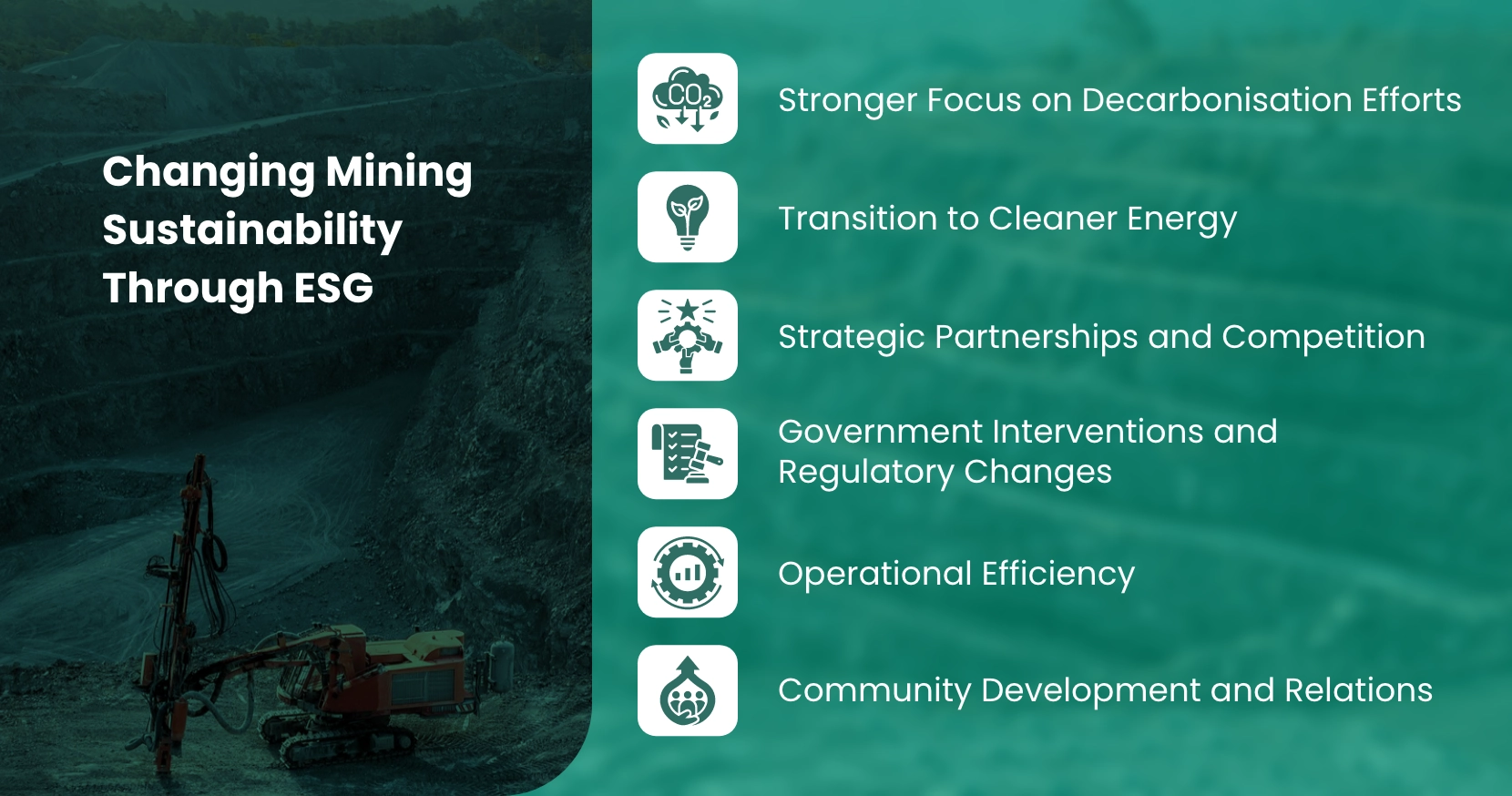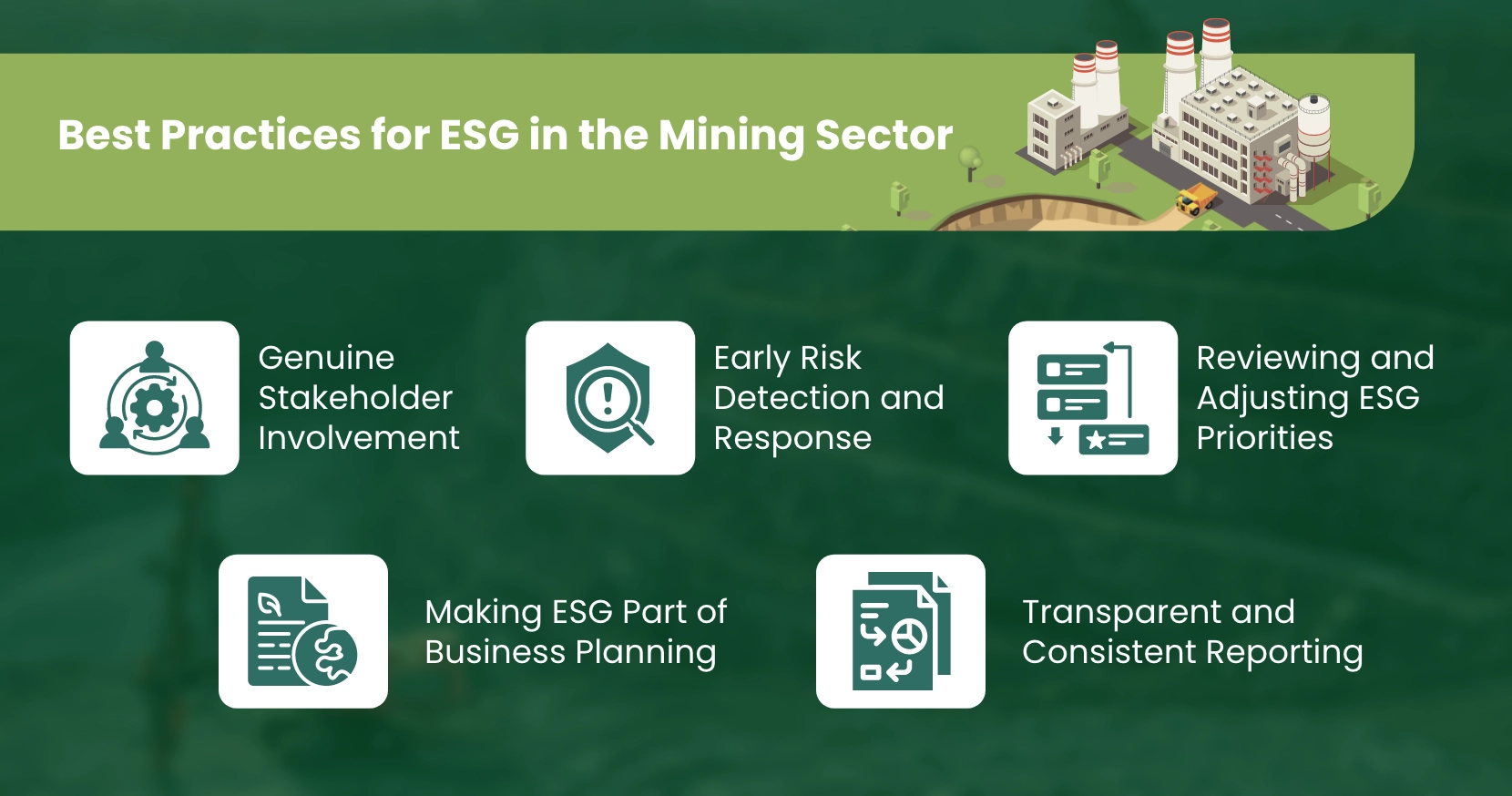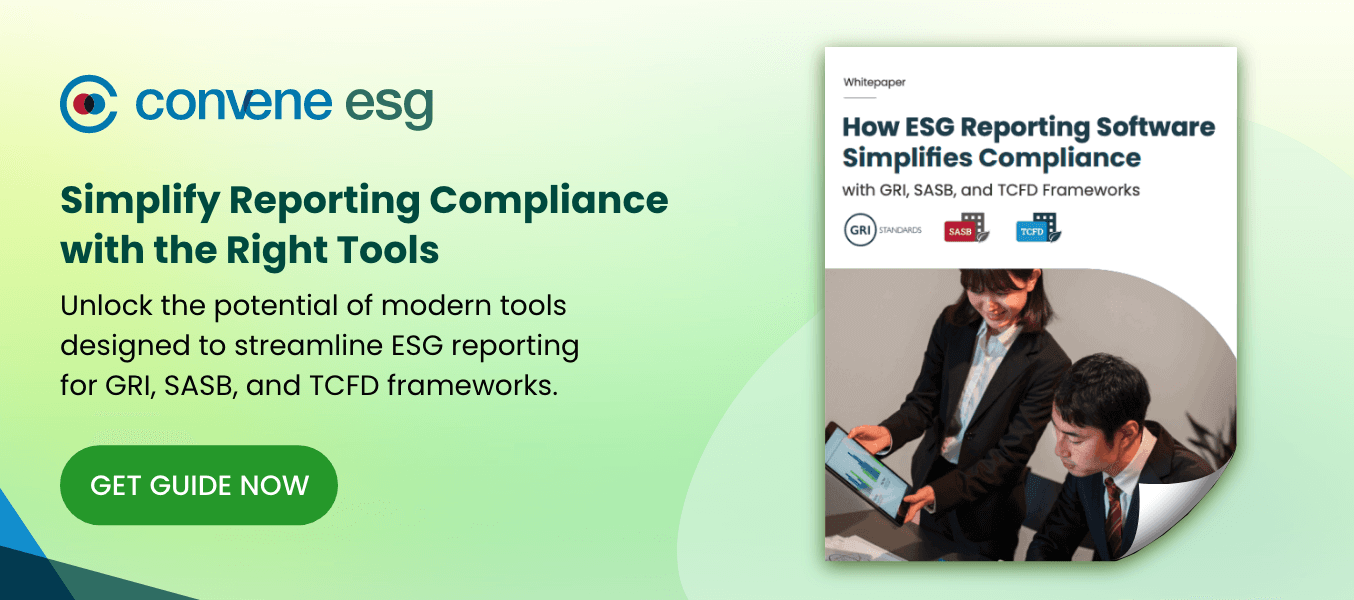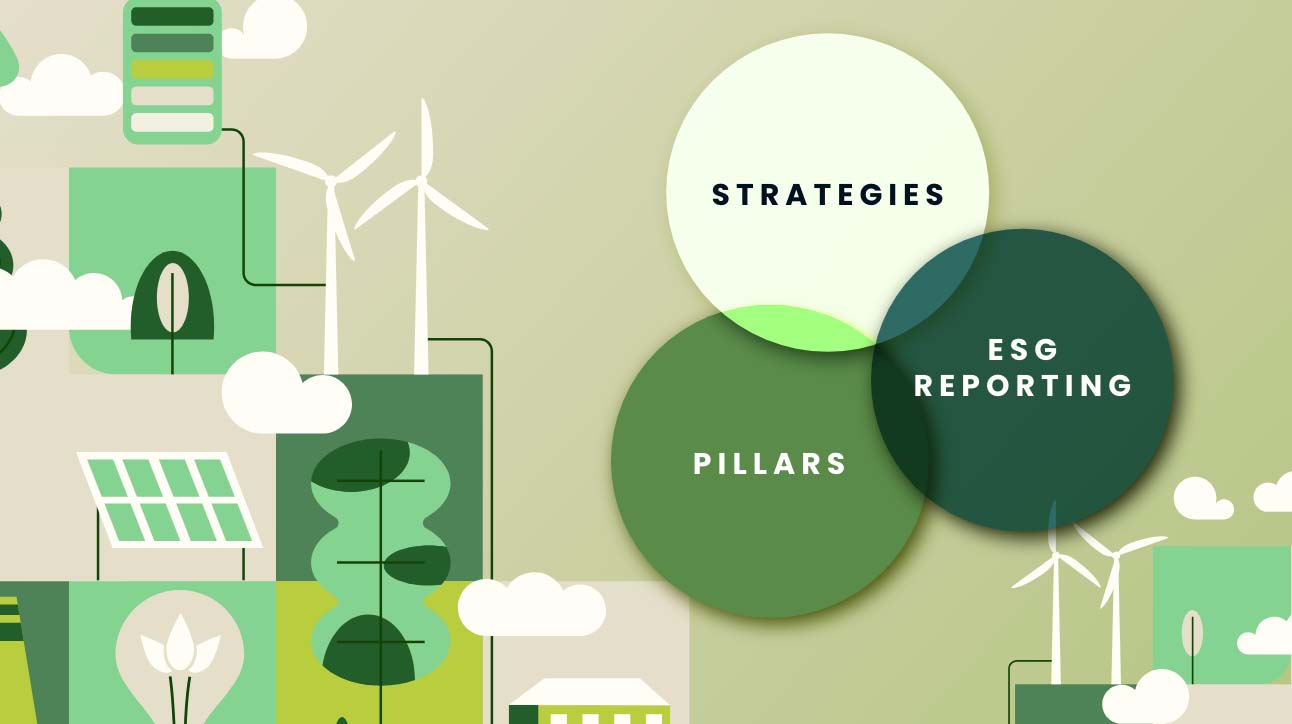The mining sector is now at the centre of the global shift towards cleaner energy and a safer environment. It powers technologies, supplies our resources, and supports the foundation of a modern and constantly developing society. But keeping up with this progress also means rethinking practices, updating systems, and engaging more closely with the people it affects.
Environmental, Social, and Governance (ESG) practices offer a greener path forward. And while some mining companies are moving in that direction, there are still gaps to address, information to clear up, and practices to reevaluate.
In this article, discover why ESG is paramount to the industry, the sustainable practices that mining companies should consider, and how ESG software can help drive better sustainability impact.
What is ESG in the mining industry?
ESG in the mining sector covers a company’s commitment to environmental stewardship, social responsibility, and robust governance practices. This includes minimising environmental footprints, keeping the well-being of people involved, and maintaining transparent and sustainable mining practices. Adopting ESG principles helps mining companies manage risks, meet regulatory requirements, and contribute positively to society and the environment.
Similar to other sectors, ESG in mining can be exhibited in the following:
- Corporate environmental impact considerations involve the reduction of greenhouse gas (GHG) emissions, managing water usage, and rehabilitating mining.
- The social aspects focus on community engagement, labour rights, and health and safety standards.
- Governance pertains to transparent decision-making processes, ethical conduct, and compliance with laws and regulations.
How Mining Affects the Society and the Environment
The mining industry remains one of the lowest-ranked sectors globally when it comes to socio-environmental performance, according to the Thomson Reuters’ Asset4 database. This shows deep-rooted challenges unique to the industry, where, unlike banking or tech, causes unavoidable harm to land, air, water, and communities. Major mining operations have led to land destruction, deforestation, water contamination, including acid mine drainage, and social issues such as forced relocations and child labour.
The consequences stretch beyond environmental effects and also deal with the social aspect of stripping land, contaminating water, and releasing harmful gases into ecosystems. Short-term profit still influences many operations, pushing back long-term sustainability in the mining industry. This sometimes results in ESG policies serving more as reactive and reputational than as constructive influence. Meanwhile, other industries, such as banking and technological hardware and software, tend to have fewer direct environmental risks and stronger social responsibility frameworks.
The data shows that the industry’s ESG gap is more incidental and reflects more profound issues. Its effects often land hardest on workers and communities near mining sites. It is structural, requiring focused interventions on a larger scale instead of generic solutions that don’t benefit the most affected.
What is the importance of ESG in mining?
Adopting ESG principles has real, measurable impacts on mining operations. At the same time, these factors are also heavily influencing operations and investor expectations.
Mining companies are under growing pressure to address environmental, social, and governance issues. A review of sustainability reports from 62 major global firms reveals how they are managing these responsibilities and where gaps remain. The findings point to uneven progress and missed opportunities, especially in broader stakeholder inclusion and meaningful engagement.
Here’s how ESG is proven to change the sustainability track of mining companies.

Stronger Focus on Decarbonisation Efforts
Mining companies are under pressure to reduce carbon emissions and are exploring decarbonisation strategies. These include integrating renewable energy sources into operations and phasing out fossil fuel-powered equipment. These initiatives are not only environmentally driven, but they also offer potential cost savings and opportunities for favourable financing. For example, BHP invested $4 billion to electrify its operations and lower emissions across its global sites. To support its shift to electric-powered equipment and transportation, the company plans to install 550 megawatts of wind, solar, and battery storage in the Pilbara region of Western Australia, which has the largest iron ore mines.
Transition to Cleaner Energy
The demand for critical minerals like lithium, cobalt, and nickel is surging with their crucial role in clean energy technologies. Governments are actively securing access to these minerals through strategic partnerships and funding initiatives. This is the case with the new mining projects outside of the European Union meant to enhance its supply chains for industrial needs and energy consumption. Targeting vital battery materials, this programme focuses on resources including graphite, cobalt, and lithium.
Strategic Partnerships and Competition
Original equipment manufacturers and end-users are actively seeking partnerships with mining companies to secure critical mineral supplies. Large collaborations include General Motors’ equity investment in a lithium project, which can support electric vehicle production. These partnerships reflect a shift in the industry, where end-users are becoming more directly involved in securing raw materials.
Government Interventions and Regulatory Changes
Even with tougher environmental rules and new tax policies in places like China, weak enforcement, high costs, and slow adoption of smart tech are still holding back progress. At the same time, mining firms are pushed to align with sustainability reporting frameworks and standards, like the Task Force on Climate-related Financial Disclosures (TCFD), and sector-specific initiatives such as Towards Sustainable Mining (TSM) and the Initiative for Responsible Mining Assurance (IRMA). They strengthen accountability, community engagement, and environmental performance across the mining sector. Yet these efforts to change mining practices will continue to fail without transparency, stronger interaction with local populations, and wiser policies that align environmental goals with economic realities.
Operational Efficiency
Mining firms that use sustainable practices, like water recycling and tailings management, can cut operating costs and minimise environmental impacts. For instance, technologies that monitor and treat toxic runoff save on future rehabilitation expenses and reduce long-term liabilities. This improves overall efficiency.
Community Development and Relations
Mining projects that invest in health services, education, and local hiring tend to build stronger relationships with surrounding communities. These efforts reduce social tension, improve project timelines, and create long-lasting economic value beyond the extraction process.
Mining projects that invest in health services, education, and local hiring tend to build stronger relationships with surrounding communities. These investments smooth out timelines and help prevent friction on the ground. By also covering the social and governance standards of ESG, companies are more likely to avoid setbacks like displacement or resistance from locals. It’s a way of doing business that leaves a positive footprint long after operations wrap up.
What are the challenges in adopting ESG in mining?
Despite the benefits, several challenges are negatively affecting the adoption of ESG in the mining industry.
Limited data and reporting lead to incomplete insights
Reliable data on sustainability in the mining industry can be difficult to obtain, especially across widespread sites and jurisdictions. A study of 57 ESG-related mining incidents showed that many risks were missed or underestimated due to vague, incomplete, or outdated assessments. One-third of the incidents weren’t predicted by companies or stakeholders, often because key information was missing or poorly handled. In some cases, data was intentionally withheld, limiting the ability of regulators and communities to act. Better data collection and transparency of reported risks and outcomes are necessary for sustainable mining practices.
Social and governance gaps weaken ESG effectiveness
Most issues of ESG in the mining sector involve environmental damage, like water contamination and biodiversity loss. Over half also relate to social conflict or pollution-related health issues. Companies often focus on technical requirements, overlooking broader social and governance impacts. Yet both are strongly linked to lowering financial risk, with social initiatives reducing conflict and good governance limiting poor decision-making. Environmental compliance matters, but this evidence suggests relationships and leadership practices may carry more weight in protecting its finances.
Mismanaged carbon offsetting undermines environmental goals
Companies often use carbon offsets to meet environmental targets. But with an imbalanced carbon offset market, unclear regulations, and weak oversight, efforts can end up ineffective and lead to greenwashing. These poorly designed offset strategies can cause environmental damage. Stronger guidance and better tools for emissions reduction are needed, including direct emissions-reduction technologies and transparent ESG reporting.
Profitability concerns discourage ESG funding
Some companies are reluctant to make investments in sustainable practices due to questions of cost and uncertain returns. Improving environmental and social practices often requires capital spending to upgrade equipment, change processes, and improve data systems or ESG reporting software. To move forward, sustainability in the mining industry should be framed as a strategy for long-term stability and investor trust, aligning ESG with future growth to reduce resistance.
Best Practices for ESG in the Mining Sector

Progress on ESG in the mining industry remains uneven, but there are clear examples from several studies of what works and what can work. Companies that lead on ESG are not just reacting to rules because they are embedding the principles into their everyday decisions. These practices help them stay ahead of regulation, reduce risks, and build stronger relationships with communities, workers, and investors.
Genuine Stakeholder Involvement
Engaging with local communities, workers, and other stakeholders early in the process, rather than after decision-making, creates a shared ownership of the outcome. This avoids conflicts and heightens the effectiveness of action items.
Early Risk Detection and Response
Addressing ESG-related risks, like pollution, land use, or human rights discussions, before they escalate saves time, costs, and reputation. Internal systems like ESG software that track both data and local concerns can best support this.
Reviewing and Adjusting ESG Priorities
ESG is not static and will keep on evolving. Companies that revisit their strategies regularly, in light of new data or feedback, tend to respond faster and more effectively to changing expectations.
Making ESG Part of Business Planning
Treating ESG in mining as part of core business planning and strategy, rather than a side effort for mere compliance, helps it align with company goals. This way, environmental and social concerns are factored into budgets, operations, and long-term growth plans.
Transparent and Consistent Reporting
Strong ESG performance starts with clear communication. Detailed and regular ESG reporting gives investors and communities a way to track progress and spot areas for improvement. To support this, many companies now use ESG software like Convene ESG to measure performance, manage data, and produce more accurate, consistent reports that are aligned with global standards.
Unearth Sustainable Mining Practices with Convene ESG
Strong ESG practices can smoothly take off with cleaner operations, stronger community ties, better risk management, and clearer ESG reporting. But to get there, companies need regular engagement with stakeholders and people on the ground, especially those most affected by mining activities. Companies need advanced tools, like ESG reporting software, to give accurate and data-driven insights to fuel good intentions and strategise efforts.
With the help of Convene ESG, mining companies can simplify data collection, improve their transparency, and keep up with global standards and community expectations. Tools that track progress, highlight gaps, and support engagement with stakeholders can turn ESG goals into lasting outcomes.
Lay the groundwork for better ESG in your mining business and expertise. Book a demo today!
Pat is a Content Writer, focusing on informative and purposeful content for Convene ESG. She has written for sustainable living and art exhibitions, and took part in research and communication projects linked to the UN's Sustainable Development Goals, further diving her into sustainability and ESG values. Outside of marketing and content, she explores new subjects in film, drawing, and occasional overthinking.
















